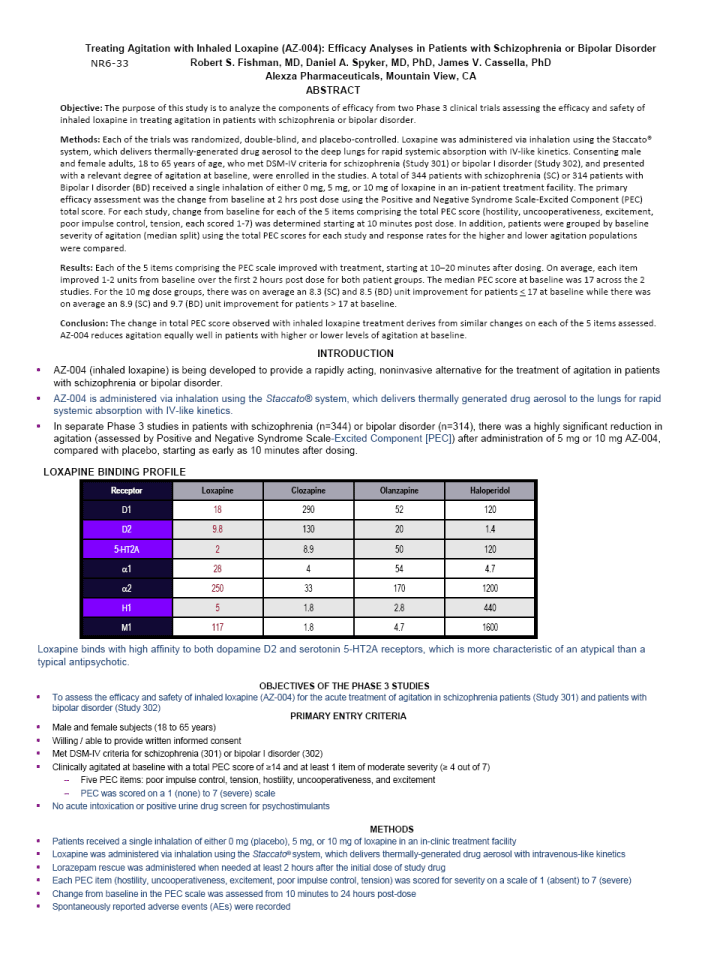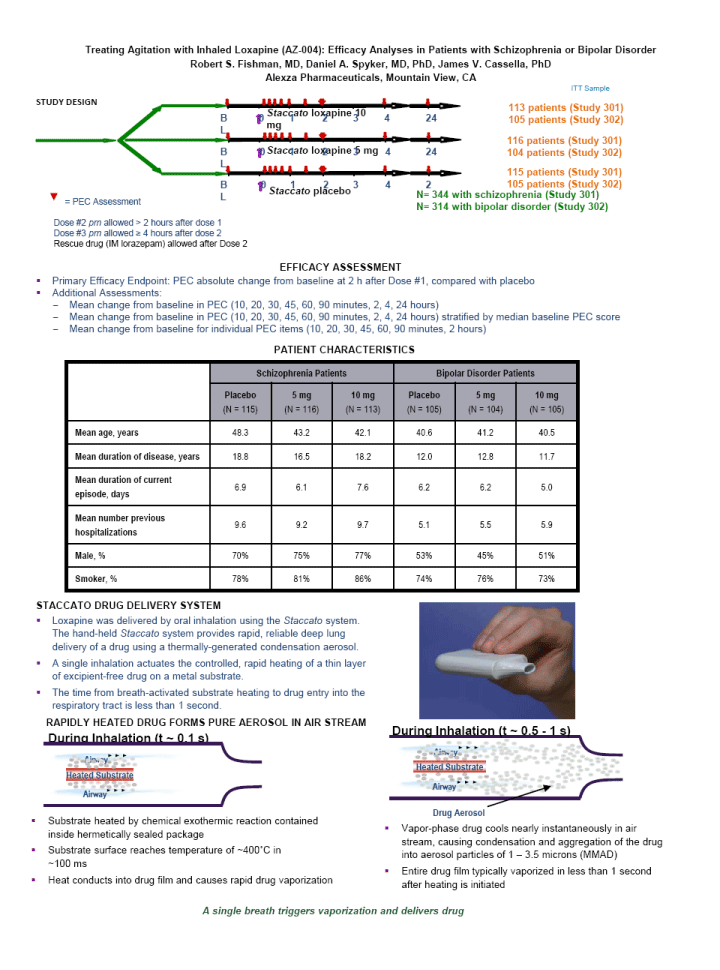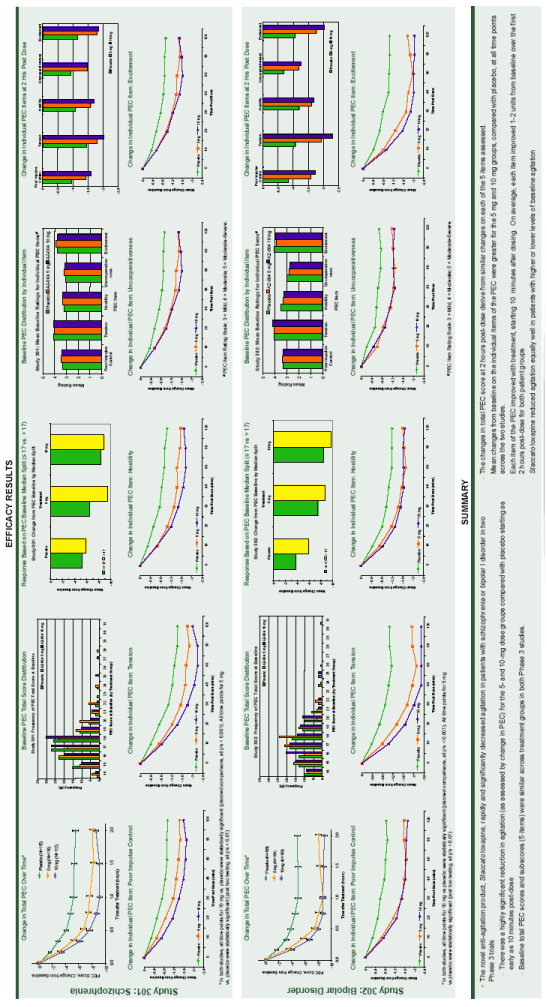Attached files
| file | filename |
|---|---|
| EX-99.1 - EX-99.1 - Alexza Pharmaceuticals Inc. | d73331exv99w1.htm |
| EX-99.3 - EX-99.3 - Alexza Pharmaceuticals Inc. | d73331exv99w3.htm |
| 8-K - FORM 8-K - Alexza Pharmaceuticals Inc. | d73331e8vk.htm |
Exhibit 99.2

| Treating Agitation with Inhaled Loxapine (AZ-004): Efficacy Analyses in Patients with Schizophrenia or Bipolar Disorder Robert S. Fishman, MD, Daniel A. Spyker, MD, PhD, James V. Cassella, PhD Alexza Pharmaceuticals, Mountain View, CA ABSTRACT Objective: The purpose of this study is to analyze the components of efficacy from two Phase 3 clinical trials assessing the efficacy and safety of inhaled loxapine in treating agitation in patients with schizophrenia or bipolar disorder. Methods: Each of the trials was randomized, double-blind, and placebo-controlled. Loxapine was administered via inhalation using the Staccato(r) system, which delivers thermally-generated drug aerosol to the deep lungs for rapid systemic absorption with IV-like kinetics. Consenting male and female adults, 18 to 65 years of age, who met DSM-IV criteria for schizophrenia (Study 301) or bipolar I disorder (Study 302), and presented with a relevant degree of agitation at baseline, were enrolled in the studies. A total of 344 patients with schizophrenia (SC) or 314 patients with Bipolar I disorder (BD) received a single inhalation of either 0 mg, 5 mg, or 10 mg of loxapine in an in-patient treatment facility. The primary efficacy assessment was the change from baseline at 2 hrs post dose using the Positive and Negative Syndrome Scale-Excited Component (PEC) total score. For each study, change from baseline for each of the 5 items comprising the total PEC score (hostility, uncooperativeness, excitement, poor impulse control, tension, each scored 1-7) was determined starting at 10 minutes post dose. In addition, patients were grouped by baseline severity of agitation (median split) using the total PEC scores for each study and response rates for the higher and lower agitation populations were compared. Results: Each of the 5 items comprising the PEC scale improved with treatment, starting at 10-20 minutes after dosing. On average, each item improved 1-2 units from baseline over the first 2 hours post dose for both patient groups. The median PEC score at baseline was 17 across the 2 studies. For the 10 mg dose groups, there was on average an 8.3 (SC) and 8.5 (BD) unit improvement for patients < 17 at baseline while there was on average an 8.9 (SC) and 9.7 (BD) unit improvement for patients > 17 at baseline. Conclusion: The change in total PEC score observed with inhaled loxapine treatment derives from similar changes on each of the 5 items assessed. AZ-004 reduces agitation equally well in patients with higher or lower levels of agitation at baseline. INTRODUCTION AZ-004 (inhaled loxapine) is being developed to provide a rapidly acting, noninvasive alternative for the treatment of agitation in patients with schizophrenia or bipolar disorder. AZ-004 is administered via inhalation using the Staccato(r) system, which delivers thermally generated drug aerosol to the lungs for rapid systemic absorption with IV-like kinetics. In separate Phase 3 studies in patients with schizophrenia (n=344) or bipolar disorder (n=314), there was a highly significant reduction in agitation (assessed by Positive and Negative Syndrome Scale-Excited Component [PEC]) after administration of 5 mg or 10 mg AZ-004, compared with placebo, starting as early as 10 minutes after dosing. LOXAPINE BINDING PROFILE Receptor Loxapine Clozapine Olanzapine Haloperidol D1 18 290 52 120 D2 9.8 130 20 1.4 5-HT2A 2 8.9 50 120 ?1 28 4 54 4.7 ?2 250 33 170 1200 H1 5 1.8 2.8 440 M1 117 1.8 4.7 1600 Loxapine binds with high affinity to both dopamine D2 and serotonin 5-HT2A receptors, which is more characteristic of an atypical than a typical antipsychotic. OBJECTIVES OF THE PHASE 3 STUDIES To assess the efficacy and safety of inhaled loxapine (AZ-004) for the acute treatment of agitation in schizophrenia patients (Study 301) and patients with bipolar disorder (Study 302) PRIMARY ENTRY CRITERIA Male and female subjects (18 to 65 years) Willing / able to provide written informed consent Met DSM-IV criteria for schizophrenia (301) or bipolar I disorder (302) Clinically agitated at baseline with a total PEC score of ^14 and at least 1 item of moderate severity (^ 4 out of 7) Five PEC items: poor impulse control, tension, hostility, uncooperativeness, and excitement PEC was scored on a 1 (none) to 7 (severe) scale No acute intoxication or positive urine drug screen for psychostimulants METHODS Patients received a single inhalation of either 0 mg (placebo), 5 mg, or 10 mg of loxapine in an in-clinic treatment facility Loxapine was administered via inhalation using the Staccato(r) system, which delivers thermally-generated drug aerosol with intravenous-like kinetics Lorazepam rescue was administered when needed at least 2 hours after the initial dose of study drug Each PEC item (hostility, uncooperativeness, excitement, poor impulse control, tension) was scored for severity on a scale of 1 (absent) to 7 (severe) Change from baseline in the PEC scale was assessed from 10 minutes to 24 hours post-dose Spontaneously reported adverse events (AEs) were recorded NR6-33 |

| Treating Agitation with Inhaled Loxapine (AZ-004): Efficacy Analyses in Patients with Schizophrenia or Bipolar Disorder Robert S. Fishman, MD, Daniel A. Spyker, MD, PhD, James V. Cassella, PhD Alexza Pharmaceuticals, Mountain View, CA STUDY DESIGN = PEC Assessment Dose #2 prn allowed > 2 hours after dose 1 Dose #3 prn allowed ^ 4 hours after dose 2 Rescue drug (IM lorazepam) allowed after Dose 2 N= 344 with schizophrenia (Study 301) N= 314 with bipolar disorder (Study 302) 115 patients (Study 301) 105 patients (Study 302) 116 patients (Study 301) 104 patients (Study 302) 113 patients (Study 301) 105 patients (Study 302) ITT Sample Staccato loxapine 10 mg Staccato loxapine 5 mg Staccato placebo B L 0 1 2 3 4 24 B L 0 1 2 3 4 24 B L 0 1 2 3 4 2 EFFICACY ASSESSMENT Primary Efficacy Endpoint: PEC absolute change from baseline at 2 h after Dose #1, compared with placebo Additional Assessments: Mean change from baseline in PEC (10, 20, 30, 45, 60, 90 minutes, 2, 4, 24 hours) Mean change from baseline in PEC (10, 20, 30, 45, 60, 90 minutes, 2, 4, 24 hours) stratified by median baseline PEC score Mean change from baseline for individual PEC items (10, 20, 30, 45, 60, 90 minutes, 2 hours) PATIENT CHARACTERISTICS Schizophrenia Patients Schizophrenia Patients Schizophrenia Patients Bipolar Disorder Patients Bipolar Disorder Patients Bipolar Disorder Patients Placebo (N = 115) 5 mg (N = 116) 10 mg (N = 113) Placebo (N = 105) 5 mg (N = 104) 10 mg (N = 105) Mean age, years 48.3 43.2 42.1 40.6 41.2 40.5 Mean duration of disease, years 18.8 16.5 18.2 12.0 12.8 11.7 Mean duration of current episode, days 6.9 6.1 7.6 6.2 6.2 5.0 Mean number previous hospitalizations 9.6 9.2 9.7 5.1 5.5 5.9 Male, % 70% 75% 77% 53% 45% 51% Smoker, % 78% 81% 86% 74% 76% 73% STACCATO DRUG DELIVERY SYSTEM Loxapine was delivered by oral inhalation using the Staccato system. The hand-held Staccato system provides rapid, reliable deep lung delivery of a drug using a thermally-generated condensation aerosol. A single inhalation actuates the controlled, rapid heating of a thin layer of excipient-free drug on a metal substrate. The time from breath-activated substrate heating to drug entry into the respiratory tract is less than 1 second. RAPIDLY HEATED DRUG FORMS PURE AEROSOL IN AIR STREAM During Inhalation (t ~ 0.1 s) Heated Substrate Airway Airwa y Heated Substrate Airway Airway Drug Aerosol During Inhalation (t ~ 0.5 - 1 s) Substrate heated by chemical exothermic reaction contained inside hermetically sealed package Substrate surface reaches temperature of ~400^C in ~100 ms Heat conducts into drug film and causes rapid drug vaporization Vapor-phase drug cools nearly instantaneously in air stream, causing condensation and aggregation of the drug into aerosol particles of 1 - 3.5 microns (MMAD) Entire drug film typically vaporized in less than 1 second after heating is initiated A single breath triggers vaporization and delivers drug |

| EFFICACY RESULTS Study 301: Schizophrenia Change in Total PEC Over Time* Baseline PEC Total Score Distribution Study 301: Frequency of PEC Total Score at Baseline Response Based on PEC Baseline Median Split (= 17 vs. > 17) Study 301: Change from PEC Baseline by Median Split Baseline PEC Distribution by Individual Item Study 301: Mean Baseline Ratings for Individual PEC Items# Change in Individual PEC Items at 2 Hrs Post Dose Change in Individual PEC Item: Poor Impulse Control Change in Individual PEC Item: Tension Change in Individual PEC Item: Hostility Change in Individual PEC Item: Uncooperativeness Change in Individual PEC Item: Excitement * In both studies, all time points for 10 mg vs. placebo were statistically significant (planned comparisons, all p’s < 0.001). All time points for 5 mg vs. placebo were statistically significant (post hoc testing, all p’s < 0.01) # PEC Item Rating Scale: 3 = Mild; 4 = Moderate; 5 = Moderate-Severe. Study 302: Bipolar Disorder Change in Total PEC Over Time* Baseline PEC Total Score Distribution Study 302: Frequency of PEC Total Score at Baseline Response Based on PEC Baseline Median Split (= 17 vs. > 17) Study 302: Change from PEC Baseline by Median Split Baseline PEC Distribution by Individual Item Study 302: Mean Baseline Ratings for Individual PEC Items# Change in Individual PEC Items at 2 Hrs Post Dose Change in Individual PEC Item: Poor Impulse Control Change in Individual PEC Item: Tension Change in Individual PEC Item: Hostility Change in Individual PEC Item: Uncooperativeness Change in Individual PEC Item: Excitement * In both studies, all time points for 10 mg vs placebo. were statistically significant (planned comparisons, all p’s < 0.001). All time points for 5 mg vs placebo were statistically significant (post hoc testing, all p’s < 0.01) # PEC Item Rating Scale: 3 = Mild; 4 = Moderate; 5 = Moderate-Severe. SUMMARY — The novel anti-agitation product, Staccato loxapine, rapidly and significantly decreased agitation in patients with schizophrenia or bipolar I disorder in two Phase 3 trials There was a highly significant reduction in agitation (as assessed by change in PEC) for the 5- and 10-mg dose groups compared with placebo starting as early as 10 minutes post-dose Baseline total PEC scores and subscores (5 items) were similar across treatment groups in both Phase 3 studies. The changes in total PEC score at 2 hours post-dose derive from similar changes on each of the 5 items assessed. Mean changes from baseline on the individual items of the PEC were greater for the 5 mg and 10 mg groups, compared with placebo, at all time points across the two studies. Each item of the PEC improved with treatment, starting 10 minutes after dosing. On average, each item improved 1-2 units from baseline over the first 2 hours post-dose for both patient groups Staccato loxapine reduced agitation equally well in patients with higher or lower levels of baseline agitation |
